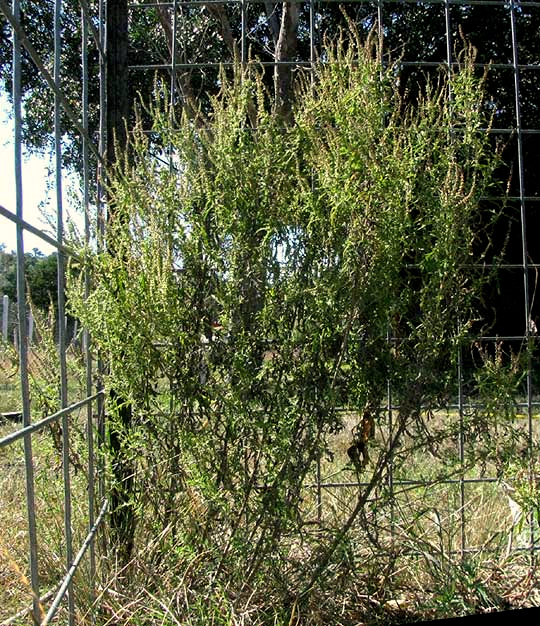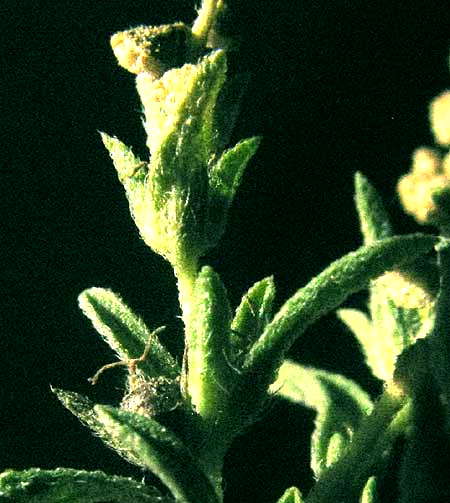Excerpts from Jim Conrad's
Naturalist Newsletter

from the November 11, 2012 Newsletter issued from the valley of the Dry Frio River in northern Uvalde County, southwestern Texas, on the southern border of the Edwards Plateau; elevation ~1750m (~5750 ft); N29.62°, W99.86°; USA
COMMON RAGWEED
The day back in August when I arrived here I found the raised beds in the abandoned garden area absolutely overgrown with weeds. One bed was solidly choked with one waist-high weed species, which also grew all around it, almost hiding the bed. I cleared it all out except for a small patch in the corner, which I kept for diversity's sake, and because I like tough things, like this weed, plus it's kind of an interesting species, and if you look at it closely you can see neat things. You can see what it looks like now in mid November, a bit ragged occupying a corner defined by deer fencing, below:

This is Common Ragweed, AMBROSIA ARTEMISIIFOLIA, the very one so famous for causing hay fever with the pollen they issue from those slender flowering heads atop the plant in the picture. A closer look at a pagoda-like flowering head, which is a raceme-type inflorescence, and the plant's deeply divided leaves, is seen at the top of this page.
The pagoda-like racemes consist almost entirely of tiny clusters of male flowers, maybe with just three or four female flowers at the racemes' bases. A close-up of two clusters of male flowers, with an inset showing a male flower's corolla removed from a cluster, is shown below:

That's a metric ruler next to the corolla showing two marks designating the length of one millimeter. Therefore the corolla is one millimeter long, or about 1/32nd of an inch. Ragweeds are members of the Composite, or Sunflower, Family, so that explains why several flowers are packed together into a bowl-like structure known as the involucre. You can see that the involucre is covered with many short, sharp, broad-based, forward projecting hairs, and that the green surface is granular, presumably with glands filled with aromatic oils. That would explain why, if you crush a Common Ragweed's leaves between your fingers, you get a pleasant, spicy odor.
So, those are the male flowers, and if you look very closely at a raceme's base you'll find some female flowers, but you have to know what you're looking for if you're to recognize what you see. Some female flowers are shown below:

In that picture's lower, left corner the dark, hairy, spherical item with slender, string-like things -- they're styles -- arising from the top, is the flower's future fruit, which will be a kind of bur with spines or tubercles. Common Ragweed's female flowers lack corollas.
Common Ragweeds are native to North America but have spread as weeds into Europe, Japan and other places.
Back on the farm in Kentucky this species reduced our soybean crops a good bit. Now it's known that night tillage of land on which Common Ragweed has deposited its seeds reduces emergence of the plant the following year by around 45%. Night tillage is exactly that -- tilling at night. Light is needed to break the dormancy of Common Ragweed's seed, so if fewer seeds are exposed to light during the tilling process, fewer will germinate.
from the October 6, 2002 Newsletter issued from the woods a few miles south of Natchez, Mississippi, USA
THE BEAUTY OF RAGWEED
On Tuesday I had to bike to town to buy supplies. As always, the difference between here and beyond the plantation gate was shocking. Of course the plants and animals are very different. Also, I am always appalled by the massive, senseless destruction of ecosystems going on everywhere between here and town.
It's pointless to talk about the destruction, for this culture is settled on its foundation of exploitation and consumption. So I'll focus on the roadside weeds. Especially I was struck by the ragweeds along Lower Woodville Road.
In college for a time I specialized in studying plant succession in abandoned fields. For example, in abandoned agricultural fields on the Piedmont in North Carolina, during the first year after abandonment the field will be overgrown with Horseweed and Large Crabgrass. On the second year these plants will be succeeded by Frost Aster and Common Ragweed. On the third year, pine seedlings appear among Broomsedge. And so it goes, with one distinct plant community predictably succeeding another, until a forest replaces the herbs. At first the forest is mostly pines, but after about 200 years the dominant trees are oaks.
In plant succession, each plant community prepares for the next by stabilizing the soil with its roots, by contributing a certain measure of organic matter to the soil, by putting extra nutrients in play in the various nutrient cycles, by supporting more diverse communities of microbes and animals, etc..
As I peddled along Lower Woodville Road this Tuesday seeing the handsome populations of ragweed, I kept all this mind, like reciting a mantra to settle a disturbed soul. Seeing a favorite woodlot bulldozed into a gully, I focused on the beautifully symmetrical forms of the ragweeds, their exquisite flower structure (male flowers in pagodalike spires), and, especially, the role they play in plant succession, nursing the soil back to enough stability and integrity to support the community of living things that will succeed them. I forced myself to think of how these ragweeds worked so elegantly to save things, giving their all to provide for the future of life on Earth. Beautiful, beautiful, beautiful I whispered to myself eyeing the ragweed as I peddled past recently sawed-down trees, scalped and eroding soil, new gravel parking lots and newly junked cars, and more and more roadside trash as I approached town.
Two ragweed species are abundant and conspicuous along Lower Woodville. Common Ragweed, AMBROSIA ARTEMISIIFOLIA, bears dissected leaves a little like those of a garden carrot, and grows to about 7 feet tall (2 m). The Giant Ragweed, AMBROSIA TRIFIDA, possesses broad, 3-lobed leaves and can get twice as large as the Common, though along the road usually it's not over 8 feet tall. There are four or five ragweed species in our area, but these are the common ones, and they are both native American species.